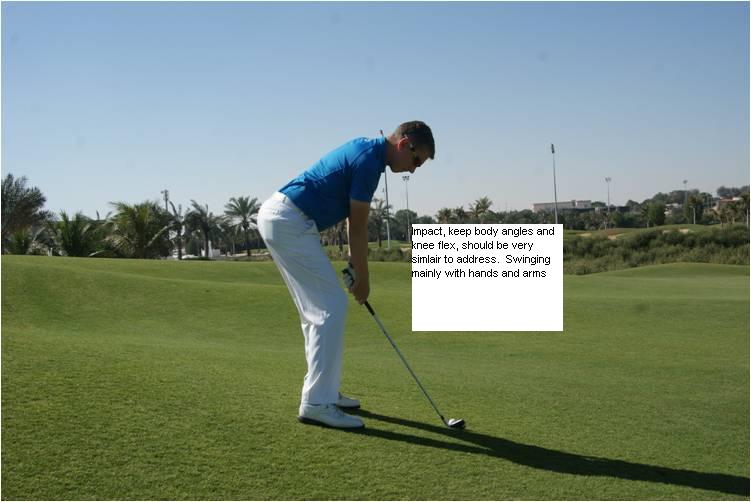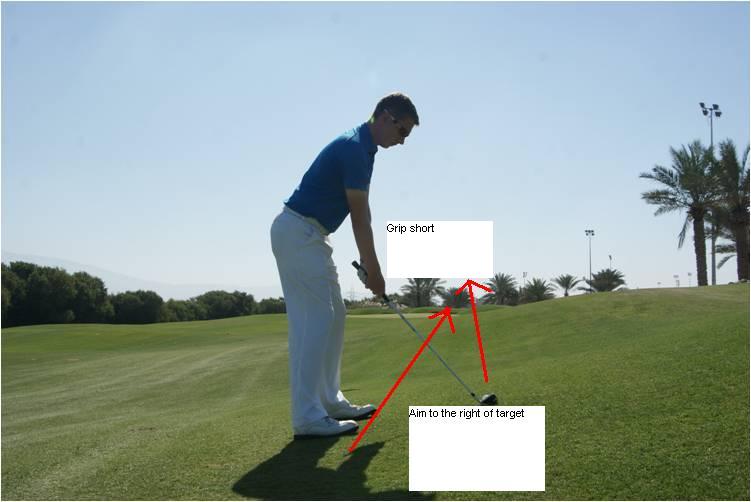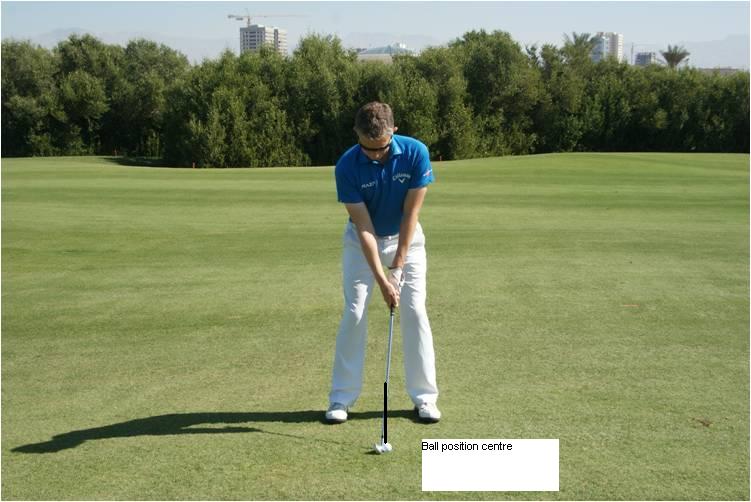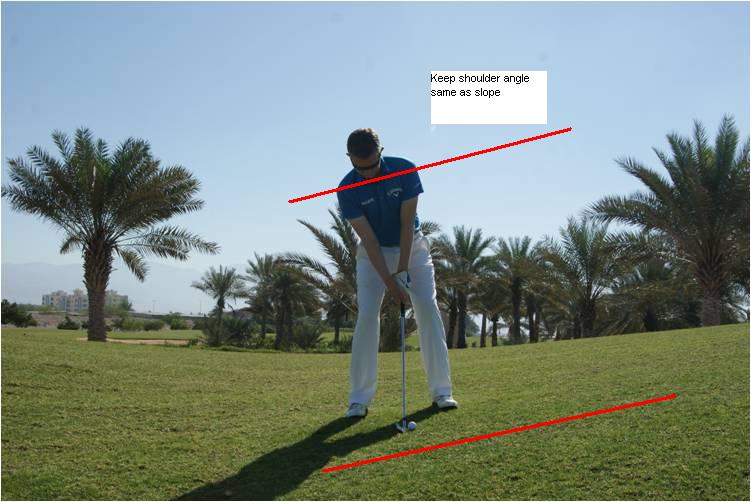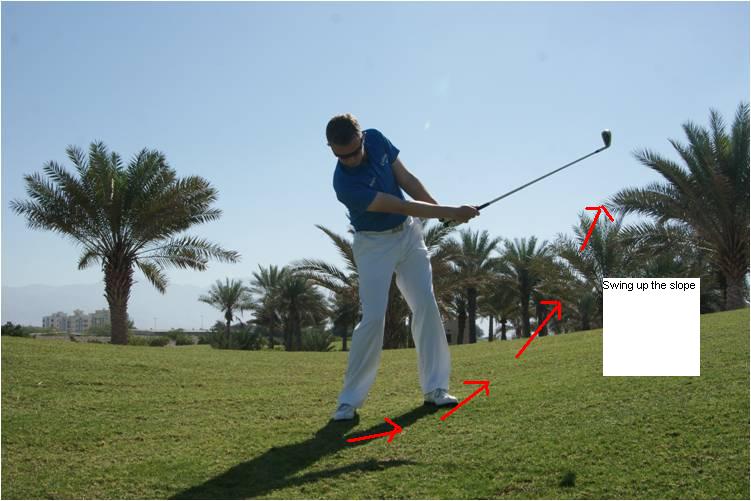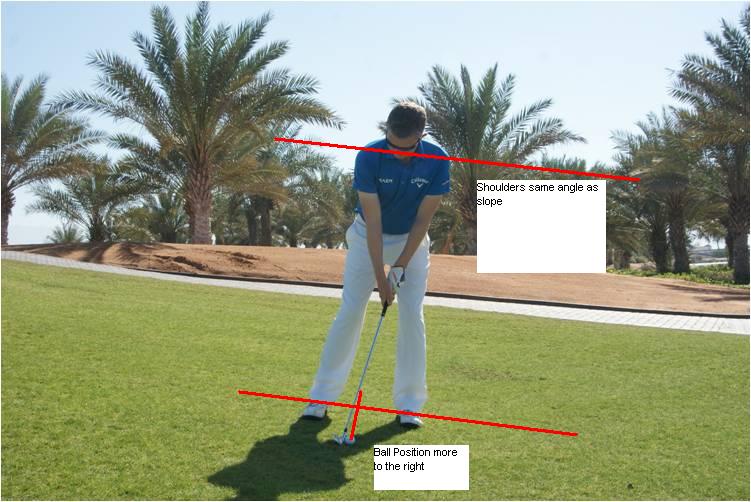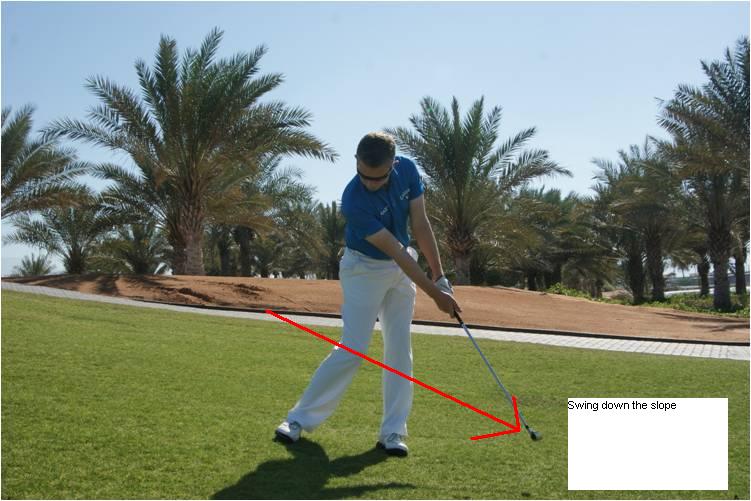Sloping Lies
How to play from sloping lies
When I used to play in Pro-Ams, or these days when I play with friends, family or my students, I can see that sloping lies are one of the biggest problems players will face. Most players, (Pros and Amateurs) from a flat lie, have no real problem. Professionals, from the fat lie, will normally give themselves a good birdie chance, and amateurs make solid contact, finishing on or around the green somewhere. When Professionals miss the green from the fairway, a high percentage of the time it will be when the ball was not sitting nicely on the grass, or it was on a sloping lie. When amateurs miss-hit their fairway shots, it is normally for the same reason, and they normally make the problem worse by not selecting the correct club. This is because the amount of balls you hit at the range off a perfectly flat lie greatly outnumber the amount you hit from sloping lies. The problem is most players do not have the awareness that it was the lie that created the problem, blaming their swing for the cause of the bad shot.
There are 4 sloping lies you will need to learn about. You will need to know what shape of shot each lie creates, the technique of how to play the shot, and how to select the correct club.
Ball Below the Feet
This is what we refer to as a Slice lie.
Shape of shot
Because the ball is below the level of your feet, your upper body angle will be more forward than normal. This will naturally steepen your swing plane, creating a left to right ball flight (slice). It is a little complicated, so I will not explain too much, but the change of the lie of the club will also increase the slice. How much the ball will curve depends on how steep the slope is – the greater the slope the greater the slice.
How
- Grip the club at maximum length, because the ball is further from your body.
- Even though your upper body is angled more forward than normal, try keeping your balance in the centre of your feet, as you would for a normal shot. Increasing your knee flex will help this as well as helping you get down to the ball.
- Aim left of your target to allow for the slice. Again, how much will depend upon the severity of the slope.
- To make solid contact, keep your lower body extremely stable and keep your knees flexed throughout your whole swing. You should feel like you are swinging mainly with your arms during the swing.
Club selection
Anytime the ball slices, the total distance of the shot will be reduced. This is because firstly, the club head speed is not transferred into the ball 100%, as the clubface is open relative to the path. Second, a sliced shot has to travel further in the air than a straight shot. Again, resulting in a shorter carry distance. Also, with this shot, because you are focusing on keeping your body stable, swinging mainly with your arms, you will not be able to create your normal club head speed. All of these mean you must select more club than normal in a slice lie situation.
Ball Above the Feet
This is what we refer to as a Hook lie.
Shape of shot
Because the ball is above the level of your feet, your upper body will be in a more upright position than normal. This in turn will naturally flatten your swing plane, creating a right to left ball flight (hook). Opposite to the Ball below your Feet lie, the change of the lie of the club will increase the hook. How much the ball will hook depends on how steep the slope is – the greater the slope the greater the hook.
How
- Grip the club a little shorter, because when the ball is above your feet, it is a little closer to your body.
- Place the ball more in the middle of the stance; a flatter more round swing requires the ball in the centre of your body.
- You will be standing taller but try keeping your balance point in the centre of your feet, as you would for a normal shot, a little less knee flex will help this.
- Aim to the right of target to allow for the hook. Again, how much will depend upon the severity of the slope.
- Try to make a normal swing, letting the ball curve to the left.
Anytime the ball hooks, it will normally travel a little further in distance. This is because the club face will be closed relative to the path, reducing the loft of the club; this produces a lower ball flight, making the ball run more. I would suggest taking less club when faced with a hook lie.
Uphill
Uphill lies tend to be the easiest of the uneven lies to play if you remember these simple rules.
Shape of shot
Because it is difficult to transfer your weight to your left side in the follow through, the club face can close at impact, creating a hook. Also, the slope will increase the loft of the club, increasing the height of the shot. How high, and how much the ball hooks, will depend upon how steep the slope is.
How
- The key point at address is that you body remains parallel to the slope. The same as it would be as if you where on a flat lie. To do this, your weight will be more on your right foot at address.
- Keep the ball positioned as normal; many make the mistake of trying to hit the ball low from an uphill lie, positioning the ball too much to the right in their stance. They swing into the slope rather than with the slope. If you want to hit the ball lower, keep the ball positioned as normal and use a less lofted club.
- Aim a little to the right to allow for the hook. How much will depend upon the severity of the slope.
- Swing up the slope and not into the slope.
If the angle of the slope is 8 degrees, 8 degrees will be added to the loft of club at address, creating a higher ball flight, reducing the distance of the shot – more club should be selected to offset this. For example, if the slope is 8 degrees, which is the same as 2 clubs, and you are using a 5 iron, your 5 iron will fly the same distance as a 7 iron, and stop the same as a 7 iron.
Downhill
This is one of the more difficult shots of sloping lies. It can be very difficult to swing with the slope and make solid contact with the ball.
Shape of shot
Because the weight stays on the left foot during the whole swing, and you swing down the slope at impact, it can be difficult to release the club, creating a slice. Also, the slope will decrease the loft of the club, decreasing the height of the shot. How low, and how much the ball slices will depend upon how steep the slope is.
How
- Again, the body should be positioned parallel to the slope, the same as it would be on a flat lie. This places more weight on the left foot at address. It is vital that you create this position and keep your weight on your left side during the swing.
- Position the ball a little more to right in the stance, again, vital to be able to create a solid impact.
- Aim to the left side to allow for the slice.
- Swing down along the slope maintaining your balance during the shot. The biggest mistake you can make is to try and fight the slope, swinging up, trying to get the ball in the air.
Opposite to the uphill lie, the degree of the slope will be reduced from the club loft, making the ball fly lower than normal. This will make the ball run more once the ball lands on the ground, so less club should be taken.
A mistake I see made at all levels of the game is using longer irons and 3 woods from serve downhill’s lies. If you consider that a 3 wood might have 15 degrees of loft, and the slope can be 10 degrees down, this only leaves 5 degrees. The result is that the ball does not get airborne, and hits the ground with a very short carry distance. Using a more lofted club from a downhill lie can often make the ball go further than the longer club, but this rule only applies went using long irons.



